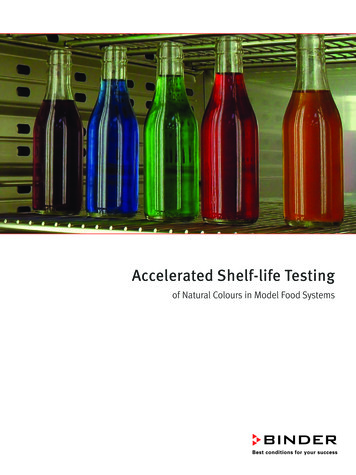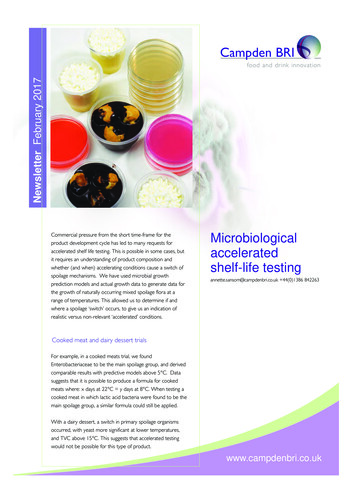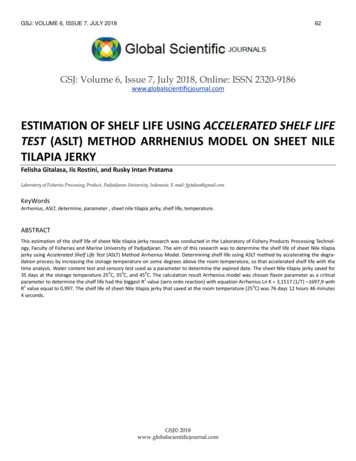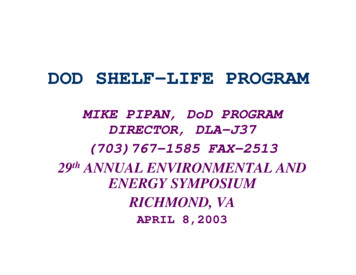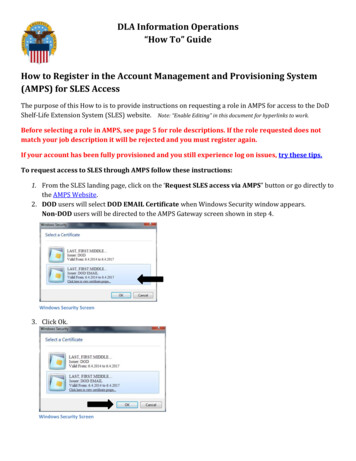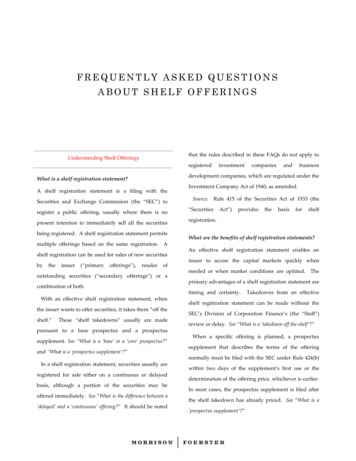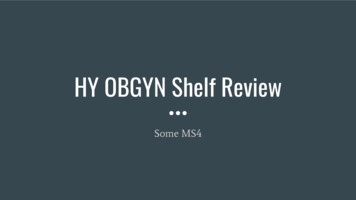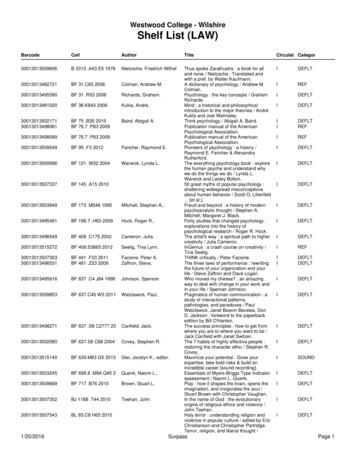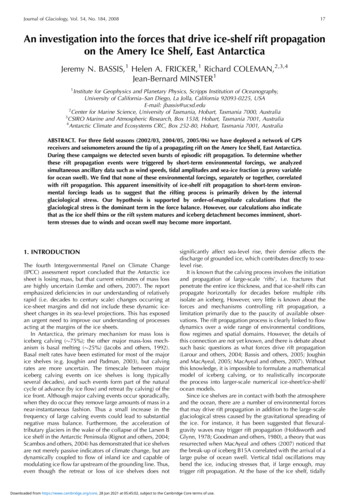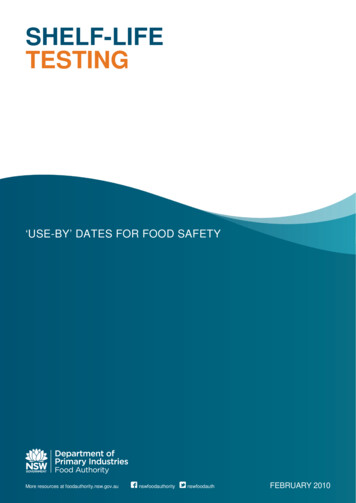
Transcription
SHELF-LIFETESTING‘USE-BY’ DATES FOR FOOD SAFETYMore resources at hFEBRUARY 2010
2ContentsExecutive summary . 3When is date marking required? . 4How is shelf life determined? . 6Product development . 6Product stability and food safety . 6Challenge tests. 8Expiry testing program . 9Use by estimation – an auditable program . 9Determination of best before dates . 9References. 10More resources at h2
3Executive summaryDate marking of foods is regulated by Standard 1.2.5 – Date Marking of Food of the Australia New Zealand FoodStandards Code.If: nutrient levels decline to unacceptable levels in a food intended by the manufacturer to form the sole source ofnutrition for a person’s diet for a specified period or the food can become microbiologically unsafe before the food noticeably spoilsthen a use by date is applicable.Where deterioration of a food affects consumer acceptance without impacting health and safety a best before dateis applicable. Foods with a shelf life of at least two years are not required to display a best before date.The length of the use by time for foods can be determined by using storage trials to estimate the physical, chemicaland microbiological stability of the food. Interpretation of results requires technical experience and competence.Some products will require additional studies such as computer models of microbial growth or challenge studies.It is the manufacturer’s responsibility to determine shelf life. Reliable use by or best before times cannot bedetermined by guesswork or by copying the shelf life of a competitor’s product.More resources at h2
4When is date marking required?Date marking of foods is regulated by Standard 1.2.5. A fact sheet (FSANZ 2003) and a user guide (ANZFA 2001)to this standard are available on the Food Standards Australia New Zealand (FSANZ) website. Standard 1.2.5, theguidance materials and other labelling standards should be consulted to understand the specific legal requirementsrelating to date marking.If food must be eaten within a certain period for health or safety reasons a use by date is required: The ‘health reason’ is applicable to food that is intended by the manufacturer to form the sole source of nutritionfor a person’s diet for a specified period. This will apply where storage affects the critical nutrient profile ofproducts such as infant formula or special dietary foods manufactured to provide the sole source of nutrition topersons who are ill or are unable to eat normal foods. The ‘safety reason’ is applicable to food that can become microbiologically unsafe before the food noticeablyspoils. This will not apply to shelf stable, frozen or most raw foods but may apply to certain chilled ready-to-eatfoods, for example chilled meals and salads. Development of use by dates for safety reasons is discussedbelow.A best before date is applicable to food where deterioration affects consumer acceptance without impacting onhealth and safety. Many product changes will affect consumer acceptance, including: rancidity texture changes moisture loss moisture gain staling flavour loss light induced changes enzymatic browning chemical browning, and microbial spoilage.There is an exemption from best before date marking for products with a shelf life of two years or longer. A scan ofsupermarket shelves identified few products that were not date marked. These included sugar, golden syrup,treacle, honey, some soft drinks, canned fruit, canned vegetables, canned soup, vinegar, some canned fish andsome cook-in sauces. Apart from these products, a shelf life of two years or longer is uncommon. While is it notmandatory in Australia some international food regulators recommend that all food be date marked to support ‘firstin – first out’ food consumption.The flow chart (over page), which is adapted from the user guide to Standard 1.2.5, helps with the decisionbetween best before and use by date marking.More resources at h2
5Food safety date marking decision supportIs the food shelf stable?YesNoIs the food frozen?YesNoIs the food a raw food that requires aprocess such as cooking to reduce foodpoisoning bacteria to make the food safeto eat?YesBest beforedate to beapplied if shelflife is less than2 years.NoIs the food a chilled ready-to-eatproduct?NoYesIs there a reasonable likelihood that thefood could contain one of the followingfood poisoning bacteria: Listeriamonocytogenes, Yersinia enterocoliticaor cold tolerant strains of Bacillus cereusor Clostridium botulinum?NoYesWill the food discernibly spoil beforelevels of bacteria would reachdangerous levels?YesNoReference: ANZFA 2001More resources at foodauthority.nsw.gov.auUse by date tobe appliednswfoodauthoritynswfoodauth2
6How is shelf life determined?There are many answers to this question, depending on the type of deterioration that the product undergoes. TheNSW Food Authority has food safety as a primary objective and so considers reliable use by dates to be essential.If use by or best before dates are overstated there is a substantial risk of damage to a business’s reputation andbrands. Food businesses must attend to all date marking requirements but this document will focus on the settingof reliable use by dates.Product developmentProduct development must be well advanced before a business can have confidence in shelf life estimates. Thebusiness must be able to reliably produce homogeneous product with consistency from batch to batch. Physicaland chemical factors that impact on the capacity of bacteria to grow, such as pH, water activity and evenness ofmix (distribution of moisture, salt, preservative or food acid) must be well controlled. The physical, chemical andmicrobiological profile of several batches of finished product must be established. The potential for productcontamination must be evaluated. The packaging materials must be identified.Product stability and food safetyInitial studies are likely to consist of storage trials under the recommended storage conditions. Refrigerated storagetrials should be run at 5 C and under conditions of mild temperature abuse equal to what might be encountered inthe commercial cold chain. Products should be inspected at suitable times and samples tested for stability of thecritical physical and chemical characteristics. These trials also provide an opportunity to commence microbiologicaltests for both spoilage organisms and the cold-tolerant pathogens named in the flow chart above. The trials shouldcontinue beyond the targeted shelf life unless the product fails earlier.Subtle changes during storage can be significant: Does pH change eg due to microbial growth or failing buffering systems? Is water redistributed within the product eg due to syneresis, condensation or a broken emulsion? Is the preservative system stable? Are there any signs of surface growth of microorganisms? Does any modified atmosphere persist for required times? Do chemicals migrate from the food-contact materials into the food? Are there any unforeseen changes to the product?The trials should lead to an understanding of target levels and ranges for the critical physical and chemicalcharacteristics of the product over the intended shelf life. The worst case or least restrictive values (maximum orminimum as the case may be) of the key chemical characteristics can then be compared to published values toevaluate the opportunity for microbial growth, particularly for the key cold-tolerant pathogens.The user guide to Standard 1.2.5 provides much of the information likely to be required to complete the evaluation.Critical values for individual factors are shown in Table 1.More resources at h2
7Table 1: Limits for growth of cold-tolerant pathogensPathogenTemperature SaltpHawCommentBacillus cereus 4 C2 7%1 4.31 0.911Grows in the presence and absence of oxygenClostridium botulinum 3.3 C1 5%1 51 0.971Require absence of oxygenListeria monocytogenes -0.4 C2 10%1 4.392 0.922Grows in the presence and absence of oxygenYersinia enterocolitica 7%1 4.22Grows in the presence and absence of oxygen -1.3 C1Table 1 - References: 1 ANZFA 2001; 2 ICMSF 1996If single factors will not prevent the growth of the cold-tolerant pathogens it is still possible that two or more factorsmight combine to inhibit growth. Microbiological growth models can be used to examine that possibility. A numberof microbial growth modelling programs are available but interpretation of results requires experience and technicalexpertise.Figure 1 is the output from a model (ComBase Predictor undated) for growth of Listeria monocytogenes in ahypothetical food. The graphic compares three food formulations; one at pH 5; the second with water activity (aw)0.94 and the third with pH 5 and aw 0.94.Figure 1: Microbial growth models in shelf life studiesCombining FactorsListeria Count200150pH 5100aw 0.94Both5000 1 2 3 4 5 6 7 8 9 10 11 12 13 14 15 16DayThis combination of reduced pH and aw significantly inhibit the growth of Listeria monocytogenes.Affects of nitrite and lactate can be explored in some of the microbial growth models. However, the modellingprograms do not extend to the impact of preservatives such as sorbates and sulphites and specialised technicalexpertise may be required to evaluate preservative efficacy.The use of all food additives must comply with Standard 1.3.1.More resources at h2
8Microbial growth models, such as ComBase, can also be used to illustrate the importance of using realistic ratherthan ideal temperatures for storage trials. Figure 2 shows the hypothetical growth rate of Listeria monocytogenes infood with a pH of 5.5 and salt content of 2%.Figure 2: The importance of using realistic temperatures in storage trialsRealistic or Ideal TemperaturesListeria Count100000100006C10004C1002C1010 1 2 3 4 5 6 7 8 9 10 11 12 13 14 15 16DayThis figure demonstrates that Listeria monocytogenes, under conditions of mild thermal abuse— temperatures thatcould well be encountered in the Australian cold chain—can grow (hypothetically) from a count of 10/g to about100,000/g within the shelf life of many chilled foods. The use of ideal temperatures in shelf life studies is badpractice and likely to be misleading.It must be noted that that model predictions are based on observations made in artificial growth media andavailable product studies. To understand how a pathogen will behave in a specific product requires challenge tests.Challenge testsA challenge test is similar to the microbiological testing used in storage trials mentioned above. The difference isthat specific cold-tolerant pathogens are added to the product prior to packaging. Storage tests on products wherepathogenic bacteria are only occasionally present are likely to be misleading. The design and evaluation ofchallenge tests should be done by an expert food microbiologist (NACMCF 2009).If ‘growth – no growth’ is not clear from other studies then challenge tests can be very useful. Their use is notrequired where it is obvious that either growth won’t occur or growth will occur. Challenge tests are used to clarifyareas of uncertainty and verify growth models for products with chemical characteristics near to the growth – nogrowth border.Cultures of pathogenic bacteria should never be introduced into a food processing factory. Challenge testsshould only be done in an off-site laboratory or research facility.More resources at h2
9Expiry testing programRetained samples from commercial batches of product should be tested for microbiological and chemical qualityupon expiry of shelf life. Newly launched products should be tested more frequently while proven products shouldbe tested occasionally. Samples for testing should be stored under realistic rather than ideal temperatureconditions. Expiry testing provides further assurance that manufacturing systems are under control.Use by estimation – an auditable programA series of linked documents can be used to provide objective evidence that use by dates are reliable.Product specification: this should list the physical, chemical and microbiological characteristics of the product. Insome cases the document might specify both release (start of shelf life) and expiry (end of shelf life) criteria. Thespecified criteria should be traceable by formu
is applicable. Foods with a shelf life of at least two years are not required to display a best before date. The length of the use by time for foods can be determined by using storage trials to estimate the physical, chemical and microbiological stability of the food. Interpretation of results requires technical experience and competence.File Size: 296KBPage Count: 11
